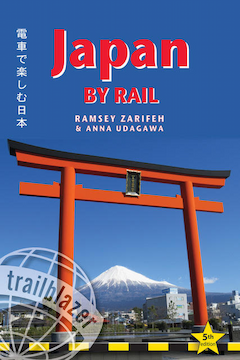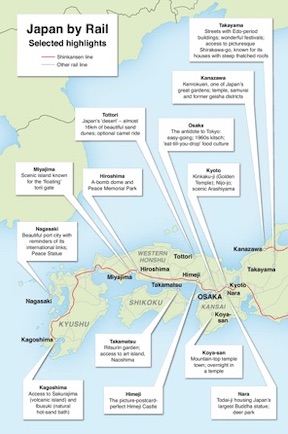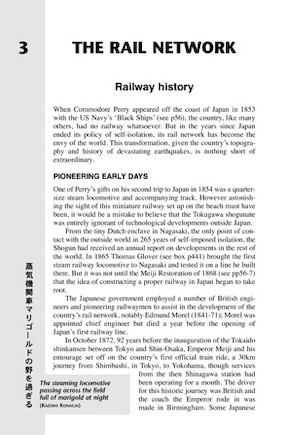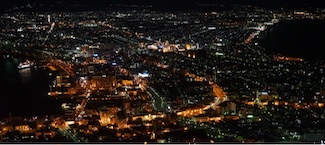
Japan By Rail by Trailblazer Guide Books
Recognised and critically acclaimed worldwide
'Excellent guide'
the sunday times (uk)
'Invaluable companion'
railway magazine (uk)
'A gem of a guide'
daily yomiuri (japan)
'A great primer'
the daily telegraph (uk)
'Highly recommended'
bullet-in magazine (japan)
Every order on JRPass gives you access to a discount to get Japan by Rail guidebook
"Think of Japan and one of the first images you’re likely to conjure up is that of a bullet train speeding past snow-capped Mt Fuji. For many, what lies beyond this image is a mystery. But hop on board that train and you’ll quickly discover what the country has to offer"
What's included in the guidebook?
- Practical information
planning, suggested itineraries, when togo, what to take, getting to Japan - City guides and maps
where to stay, where to eat, what to see in 26 towns and cities; historical and cultural background - Rail service summaries
bullet trains and all routes in this guide - Kilometre-by-kilometre route guides
train journeys from the coast into the mountains, from temple retreat to sprawling metropolis and from sulphurous volcano to windswept desert; 33 route maps - Plus
Japanese phrases, customs and etiquette
Interview with the author - Ramsey Zarifeh
Enjoy the read!
Why did you go to Japan in the first place?
While at university, I heard about the JET programme - a Japanese government-sponsored programme offering foreign graduates the chance to go to Japan to teach English. I seized the opportunity, because I had always been fascinated by Japan. The country seemed so alien, so remote, and so far in the future in terms of its technology and gadgets. I wanted to see it close up, and understand it better, for myself.
What made you want to write a book about Japan - in particularly travelling around by train?
After I completed two years on the JET programme, teaching English in rural Miyazaki prefecture on the southern island of Kyushu, I realised that I wasn’t ready to return home, and wanted to see more of what Japan had to offer. I have always had a passion for travelling by train, and - knowing that the country had an extensive network of railway lines that linked all four main islands - I pitched the idea of a ‘Japan by Rail’ guide book to UK-based publisher Trailblazer. I’m glad I did, because the book has now been in print for more than 15 years, with a succession of new editions, and has become the definitive guide to getting around and seeing as much of the country as possible while riding the rails.
What places stand out for you as must-sees in Japan, and which can be reached by rail?
I think my favourite place to visit is the ancient mountain-top temple town of Koya-san. It is stunning at any time of year, and a world away from the hi-tech, neon-lit cityscapes Japan is famous for. On Koya-san, visitors have the opportunity to stay overnight in a temple, eat a delicious vegetarian meal prepared by resident monks, and take part in meditation and early-morning prayers. It’s a unique place and worth the trip by rail that winds its way up into the mountains.
There are plenty of other highlights: for a fun urban shopping and entertainment experience, I like to head to the regional capital of Kyushu, Fukuoka - a city that always feels to me to be very open to the world, where pop-up fashion boutiques and street-side noodle bars are always packed in the evening with young and old alike. From Fukuoka, I recommend taking the bullet train further south to Kagoshima, on the southern tip of Kyushu, from where it’s just a short boat ride to the volcanic island of Sakurajima. A truly out-of-this-world experience! Also from Kagoshima you can take a really stylish train (whose name means Ibusuki Treasure box) to Ibusuki and have a sand bath in naturally hot sand – another out-of-this-world experience!
How can 'Japan by Rail' help a visitor to the country plan a trip?
I always tell people that the secret to travelling around Japan is the Japan Rail Pass. But the key to making the most of the pass is ‘Japan by Rail’. The book is a one-stop shop for planning any trip around the country, and for seeing as much of what Japan has to offer as possible. The railway can take you into the biggest cities and tiniest remote villages, to hot-spring and ski resorts, along the coast, and even to the desert.
Our book shows how you can do all of this and more, with stop-off suggestions along all the routes we cover, together with suggestions for where to stay and what to eat. We even give you tips on which side of the train to sit on to enjoy the best views (including that iconic Insta shot of snow-capped Mt Fuji!). I like to think that a true adventure awaits anyone who has a rail pass in one hand and our book in the other. With ‘Japan by Rail’ there’s really no limit to what you can see and do, as you glide effortlessly around the country on a railway network that is quite simply the best in the world!
Which do you prefer: high-speed bullet trains or local trains?
In all honesty, and this would be my advice to anyone going to Japan, try both! The bullet train is an experience like no other, where you glide across the country in comfort. The views can become blink-and-you’ll-miss-it territory, but for me there is nothing more satisfying than settling back on a bullet train, kicking back for a few hours, seeing the country flash forward before your eyes, while enjoying an ekiben (tasty lunch boxes bought at railway stations and consumed on board). Shinkansen are all about getting you where you want to go as quickly as possible but they also offer other experiences: Genbi shinkansen has an art gallery and on the Toreiyu Tsubasa you can watch the world go by with your feet in a warm foot-bath.
Of course, the bullet train is only part of the adventure of travelling around Japan. Jump on board one of the local railway lines, and you’ll see a very different Japan. Trains pass - at a far more leisurely pace - through rice fields and deep into the mountains. On board local trains you might find yourself sitting next to a family on a day out, a grandmother on her way to the shops, a farmer heading to market, or school children on their way to or from school.
How easy is to get around by train, and is there a danger of not knowing when to get on or off?
Each and every station in Japan - no matter how remote - has platform signs in English with the name of the stop (as well as the stop before, and the next stop along the line), so it’s hard to make a mistake and get off at the wrong place. Also announcements are made in English on many services, even on local lines if they go to areas tourists visit.
Even better, the Japanese rail network is one of the most punctual and efficient in the world. You can literally set your watch by departing and arriving trains. That makes planning journeys across the country hassle-free. ‘Japan by Rail’ will also help in this respect, as the book contains sample itineraries as well as train frequency information for all of the most popular routes. So hop on board and enjoy the ride!
Let's take a look at some examples
Japan by Rail: Selected highlights
The book contains detailed maps of Japan, with suggested itineraries, what do eat, historical and cultural background, mile-by-mile route guides, secret tips by locals and much more.
The Rail Network Railway History
Japan has a rich history of railway travel, more so than any other country. Take a step back into time and learn how the first steam engines from Europe came over and became the ultra fast Shinkansen network we know today.
Find amazing itinerary recommendations
Japan has a rich array of incredible places, cultures and becautiful landscapes. While we have a list of a few recommended itineraries on our website, this ebook will give you a much more indept list of possibilities that you might have a chance too experience in person.
Download PDF sample
Download the first chapter of Japan By Rail eBook for free. Available in PDF format.





